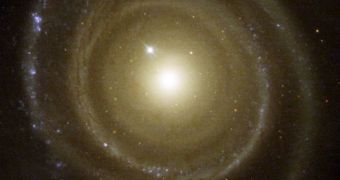Spiral galaxies such as our Milky Way are believed to unwind their arms inwards in the spinning directions; however, it seems that not only this is not always the case, but some can also present arms unwinding towards inner and outer regions regardless of the spinning direction of the galactic disk. The original paper containing the controversial new findings was published in 2002, but at the time the international astronomic community disregarded it, mostly due to the fact that the observations regarding the inner leading outwards spinning arms of the NGC 4622 galaxy were inconclusive, because the galactic disk presents only a 19 degrees tilt related to the direction of our planet.
The existence of galaxies with outwards spinning arms could seem for most of us some kind of mistake in data interpretation, but such structures are as real as they can get. The reviewed study conducted by a team of astronomers, led by Dr. Gene Byrd and Dr. Rob Buta from the University of Alabama, clearly shows how the galaxy lying more than 200 million light years away from Earth presents a galactic disk with an arm winding in the opposite natural direction of rotation of the disk material.
Furthermore, the study proves once again the existence of the inner leading arm of the galaxy, discovered in 2001 after applying a Fourier transformation to an image of the NGC4622 galaxy, taken by the Hubble Space Telescope.
Byrd argues that, in the case of similar structures, both the inner winding and outer winding arms of the galactic disk must present a series of leading arms pointing in the contrary direction, regardless of the spinning direction of the material disk, thus one pair of arms must lead while the other will closely follow the motion of the previous. This means that a spiral galaxy must always present at least one single inner leading arm.
The original study published nearly six years ago had been rejected by most of the astrophysics community due to the low angle of view of the galactic disk, which interfered with the observations related to the inner arm of NGC4622, that could have given rise to false results. Instead, the study recently published uses a new Fourier component of the image, in a way that the low angle of the view does not interfere with the dust clouds in the galactic disk.
Furthermore, the team proved that both Fourier methods are effective while making detailed analysis of the galactic disk. Also a gap within the disk suggests that NGC4622 might have merged with a smaller galaxy in the past.

 14 DAY TRIAL //
14 DAY TRIAL //